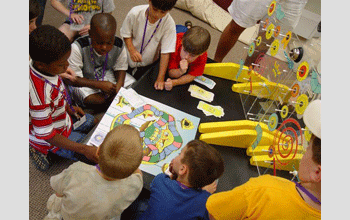Multimedia Gallery
LSU EPSCoR Center (Image 3)
LSU EPSCoR Center (Image 3)
Elementary students playing Widget Works at Louisiana State University's (LSU) Center for BioModular Multi-Scale Systems (CBM2) Summer Science Adventure Camp. Widget Works, a game that teaches science basics to elementary school students, was designed by six LSU sophomore mechanical engineering design students, who took on the assignment as part of an independent study course. They, along with a senior graphics design team, designed the game, developed three prototypes, employed the assistance of elementary school teachers to categorized questions, and tested it at a local elementary science class and CBM2 summer programs.
Recently funded by a 3 year National Science Foundation (NSF) EPSCoR grant (EPS 03-46411), CBM2 is a Center of Excellence for micro/nanofabrication, with applications in genomics, proteomics and pharmaceutical research at LSU. The center, in conjunction with the Center for Advanced Microstructures and Devices (CAMD) at LSU, contains state-of-the-art equipment for the fabrication of high-aspect ratio microstructures in a variety of materials (glass, polymers, metals and ceramics, to name a few) over several different size domains (nm to mm). CBM2 also has expertise in fluidics (simulation/modeling), material characterization/modification, and reagent development. CBM2 has a service program in micro/nanofabrication to assist outside users.
To learn more, visit the CBM2 Web site. (Date of Image: 2006-2007) [One of 3 related images. See Next Image.]
Credit: Center for BioModular Multi-Scale Systems, Louisiana State University
Images and other media in the National Science Foundation Multimedia Gallery are available for use in print and electronic material by NSF employees, members of the media, university staff, teachers and the general public. All media in the gallery are intended for personal, educational and nonprofit/non-commercial use only.
Images credited to the National Science Foundation, a federal agency, are in the public domain. The images were created by employees of the United States Government as part of their official duties or prepared by contractors as "works for hire" for NSF. You may freely use NSF-credited images and, at your discretion, credit NSF with a "Courtesy: National Science Foundation" notation.
Additional information about general usage can be found in Conditions.
Also Available:
Download the high-resolution JPG version of the image. (328 KB)
Use your mouse to right-click (Mac users may need to Ctrl-click) the link above and choose the option that will save the file or target to your computer.



